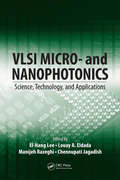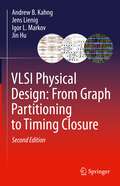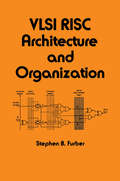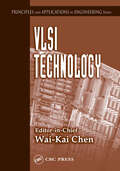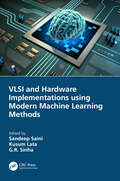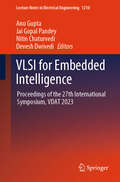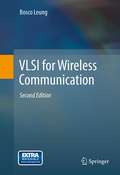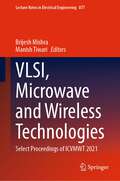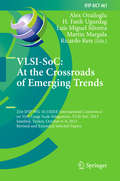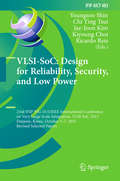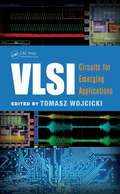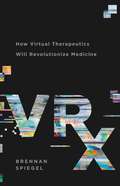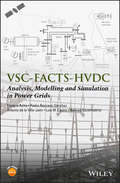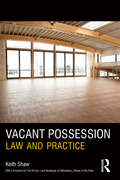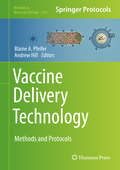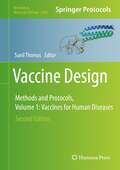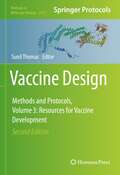- Table View
- List View
VLSI Micro- and Nanophotonics: Science, Technology, and Applications
by Manijeh Razeghi El-Hang Lee Louay A. Eldada Chennupati JagadishAddressing the growing demand for larger capacity in information technology, VLSI Micro- and Nanophotonics: Science, Technology, and Applications explores issues of science and technology of micro/nano-scale photonics and integration for broad-scale and chip-scale Very Large Scale Integration photonics. This book is a game-changer in the sense that it is quite possibly the first to focus on "VLSI Photonics". Very little effort has been made to develop integration technologies for micro/nanoscale photonic devices and applications, so this reference is an important and necessary early-stage perspective on this field. New demand for VLSI photonics brings into play various technological and scientific issues, as well as evolutionary and revolutionary challenges—all of which are discussed in this book. These include topics such as miniaturization, interconnection, and integration of photonic devices at micron, submicron, and nanometer scales.With its "disruptive creativity" and unparalleled coverage of the photonics revolution in information technology, this book should greatly impact the future of micro/nano-photonics and IT as a whole. It offers a comprehensive overview of the science and engineering of micro/nanophotonics and photonic integration. Many books on micro/nanophotonics focus on understanding the properties of individual devices and their related characteristics. However, this book offers a full perspective from the point of view of integration, covering all aspects of benefits and advantages of VLSI-scale photonic integration—the key technical concept in developing a platform to make individual devices and components useful and practical for various applications.
VLSI Physical Design: From Graph Partitioning to Timing Closure
by Igor L. Markov Andrew B. Kahng Jens Lienig Jin HuThe complexity of modern chip design requires extensive use of specialized software throughout the process. To achieve the best results, a user of this software needs a high-level understanding of the underlying mathematical models and algorithms. In addition, a developer of such software must have a keen understanding of relevant computer science aspects, including algorithmic performance bottlenecks and how various algorithms operate and interact. This book introduces and compares the fundamental algorithms that are used during the IC physical design phase, wherein a geometric chip layout is produced starting from an abstract circuit design. This updated second edition includes recent advancements in the state-of-the-art of physical design, and builds upon foundational coverage of essential and fundamental techniques. Numerous examples and tasks with solutions increase the clarity of presentation and facilitate deeper understanding. A comprehensive set of slides is available on the Internet for each chapter, simplifying use of the book in instructional settings.“This improved, second edition of the book will continue to serve the EDA and design community well. It is a foundational text and reference for the next generation of professionals who will be called on to continue the advancement of our chip design tools and design the most advanced micro-electronics.” Dr. Leon Stok, Vice President, Electronic Design Automation, IBM Systems Group“This is the book I wish I had when I taught EDA in the past, and the one I’m using from now on.” Dr. Louis K. Scheffer, Howard Hughes Medical Institute“I would happily use this book when teaching Physical Design. I know of no other work that’s as comprehensive and up-to-date, with algorithmic focus and clear pseudocode for the key algorithms. The book is beautifully designed!”Prof. John P. Hayes, University of Michigan“The entire field of electronic design automation owes the authors a great debt for providing a single coherent source on physical design that is clear and tutorial in nature, while providing details on key state-of-the-art topics such as timing closure.”Prof. Kurt Keutzer, University of California, Berkeley“An excellent balance of the basics and more advanced concepts, presented by top experts in the field.” Prof. Sachin Sapatnekar, University of Minnesota
VLSI Risc Architecture and Organization (Electrical And Computer Engineering Ser. #56)
by S.B. FurberFirst Published in 2017. Routledge is an imprint of Taylor & Francis, an Informa company.
VLSI Technology
by Wai-Kai ChenAs their name implies, VLSI systems involve the integration of various component systems. While all of these components systems are rooted in semiconductor manufacturing, they involve a broad range of technologies. This volume of the Principles and Applications of Engineering series examines the technologies associated with VLSI systems, including
VLSI and Hardware Implementations using Modern Machine Learning Methods
by Sandeep SainiMachine learning is a potential solution to resolve bottleneck issues in VLSI via optimizing tasks in the design process. This book aims to provide the latest machine-learning–based methods, algorithms, architectures, and frameworks designed for VLSI design. The focus is on digital, analog, and mixed-signal design techniques, device modeling, physical design, hardware implementation, testability, reconfigurable design, synthesis and verification, and related areas. Chapters include case studies as well as novel research ideas in the given field. Overall, the book provides practical implementations of VLSI design, IC design, and hardware realization using machine learning techniques. Features: Provides the details of state-of-the-art machine learning methods used in VLSI design Discusses hardware implementation and device modeling pertaining to machine learning algorithms Explores machine learning for various VLSI architectures and reconfigurable computing Illustrates the latest techniques for device size and feature optimization Highlights the latest case studies and reviews of the methods used for hardware implementation This book is aimed at researchers, professionals, and graduate students in VLSI, machine learning, electrical and electronic engineering, computer engineering, and hardware systems.
VLSI for Embedded Intelligence: Proceedings of the 27th International Symposium, VDAT 2023 (Lecture Notes in Electrical Engineering #1210)
by Anu Gupta Jai Gopal Pandey Nitin Chaturvedi Devesh DwivediThis book constitutes the proceedings of the 27th International Symposium on VLSI Design and Test, VDAT 2023. The 32 regular papers and 16 short papers presented in this book are carefully reviewed and selected from 220 submissions. They are organized in topical sections as follows: Low-Power Integrated Circuits and Devices; FPGA-Based Design and Embedded Systems; Memory, Computing, and Processor Design; CAD for VLSI; Emerging Integrated Circuits and Systems; VLSI Testing and Security; and System-Level Design.
VLSI for Wireless Communication
by Bosco LeungVLSI for Wireless Communication, Second Edition, an advanced level text book, takes a system approach starting with an overview of the most up to date wireless systems and the transceiver architecture available today. Wireless standards are first introduced (updated to include the most recent 3G/4G standards in the second edition), and translates from a wireless standard to the implementation of a transceiver. This system approach is particularly important as the level of integration in VLSI increases and coupling between system and component design becomes more intimate. VLSI for Wireless Communication, Second Edition, illustrates designs with full design examples. Each chapter includes at least one complete design example that helps explain the architecture/circuits presented in this text. This book has close to 10 homework problems at the end of each chapter. A complete solutions manual is available on-line. VLSI for Wireless Communication, Second Edition, is designed as a primary text book for upper-undergraduate level students and graduate level students concentrating on electrical engineering and computer science. Professional engineers and researchers working in wireless communications, circuit design and development will find this book valuable as well.
VLSI, Communication and Signal Processing: Select Proceedings of the 5th International Conference, VCAS 2022 (Lecture Notes in Electrical Engineering #1024)
by R. K. Nagaria V. S. Tripathi Carlos Ruiz Zamarreno Yogendra Kumar PrajapatiThis book covers a variety of topics in Electronics and Communication Engineering, especially in the area of microelectronics and VLSI design, communication systems and networks, and signal and image processing. The content is based on papers presented at the 5th International Conference on VLSI, Communication and Signal Processing (VCAS 2022). The book also discusses the emerging applications of novel tools and techniques in image, video, and multimedia signal processing. This book is useful to students, researchers, and professionals working in the electronics and communication domain.
VLSI, Microwave and Wireless Technologies: Select Proceedings of ICVMWT 2021 (Lecture Notes in Electrical Engineering #877)
by Manish Tiwari Brijesh MishraThis book comprises the proceedings of the International Conference on VLSI & Microwave and Wireless Technologies (ICVMWT-2021). The book includes peer-reviewed papers on the core technological developments in emerging fields like wireless communication, RF microwave/radar, VLSI, optical communication, etc. The book will serve as a valuable reference resource for academics and researchers across the globe.
VLSI-SoC: At the Crossroads of Emerging Trends
by Ricardo Reis Alex Orailoglu H. Fatih Ugurdag Luís Miguel Silveira Martin MargalaThis book contains extended and revised versions of the best papers presented at the 21st IFIP WG 10. 5/IEEE International Conference on Very Large Scale Integration, VLSI-SoC 2013, held in Istanbul, Turkey, in October 2013. The 11 papers included in the book were carefully reviewed and selected from the 48 full papers presented at the conference. An extended version of a previously unpublished high-quality paper from VLSI-SoC 2012 is also included. The papers cover a wide range of topics in VLSI technology and advanced research. They address the current trend toward increasing chip integration and technology process advancements bringing about stimulating new challenges both at the physical and system-design levels, as well as in the test of these systems.
VLSI-SoC: Design for Reliability, Security, and Low Power
by Ricardo Reis Youngsoo Shin Chi Ying Tsui Jae-Joon Kim Kiyoung ChoiThis book contains extended and revised versions of the best papers presented at the 23rd IFIP WG 10. 5/IEEE International Conference on Very Large Scale Integration, VLSI-SoC 2015, held in Daejeon, Korea, in October 2015. The 10 papers included in the book were carefully reviewed and selected from the 44 full papers presented at the conference. The papers cover a wide range of topics in VLSI technology and advanced research. They address the current trend toward increasing chip integration and technology process advancements bringing about new challenges both at the physical and system-design levels, as well as in the test of these systems.
VLSI: Circuits for Emerging Applications (Devices, Circuits, and Systems #34)
by Krzysztof Iniewski Tomasz WojcickiRecently the world celebrated the 60th anniversary of the invention of the first transistor. The first integrated circuit (IC) was built a decade later, with the first microprocessor designed in the early 1970s. Today, ICs are a part of nearly every aspect of our daily lives. They help us live longer and more comfortably, and do more, faster. All this is possible because of the relentless search for new materials, circuit designs, and ideas happening on a daily basis at industrial and academic institutions around the globe. Showcasing the latest advances in very-large-scale integrated (VLSI) circuits, VLSI: Circuits for Emerging Applications provides a balanced view of industrial and academic developments beyond silicon and complementary metal–oxide–semiconductor (CMOS) technology. From quantum-dot cellular automata (QCA) to chips for cochlear implants, this must-have resource: Investigates the trend of combining multiple cores in a single chip to boost performance of the overall system Describes a novel approach to enable physically unclonable functions (PUFs) using intrinsic features of a VLSI chip Examines the VLSI implementations of major symmetric and asymmetric key cryptographic algorithms, hash functions, and digital signatures Discusses nonvolatile memories such as resistive random-access memory (Re-RAM), magneto-resistive RAM (MRAM), and floating-body RAM (FB-RAM) Explores organic transistors, soft errors, photonics, nanoelectromechanical (NEM) relays, reversible computation, bioinformatics, asynchronous logic, and more VLSI: Circuits for Emerging Applications presents cutting-edge research, design architectures, materials, and uses for VLSI circuits, offering valuable insight into the current state of the art of micro- and nanoelectronics.
VOB/B nach Ansprüchen
by Christian ZannerDas Fachbuch vermittelt in allgemein verständlicher Form die Grundkenntnisse der VOB/B und gibt Sicherheit bei der Durchsetzung und Abwehr von Ansprüchen aller am Bau Beteiligten während der Bauabwicklungsphase und der sich anschließenden Mängelhaftung. Das Buch ist das ideale Hilfsmittel auf jeder Baustelle. Durch den Aufbau des Werkes nach Ansprüchen kann es in der Praxis als Nachschlagewerk für einzelne Situationen herangezogen werden. Die 6. Auflage berücksichtigt die aktuelle Rechtsprechung und die neuen Regelungen der VOB/B 2016, die am 18.04.2016 in Kraft getreten ist.
VOB/B nach Ansprüchen: Entscheidungshilfen für Auftraggeber, Planer und Bauunternehmen (Bau- und Architektenrecht nach Ansprüchen)
by Christian ZannerDas Fachbuch vermittelt in allgemein verständlicher Form alle wichtigen Kenntnisse zur VOB/B und dem Baurecht im BGB. Es gibt Sicherheit bei der Durchsetzung und Abwehr von Ansprüchen aller am Bau Beteiligten während der Bauabwicklungsphase und der sich anschließenden Mängelhaftung. Das Fachbuch ist das ideale Hilfsmittel auf jeder Baustelle. Durch den Aufbau des Werkes nach Ansprüchen kann es in der Praxis als Nachschlagewerk für einzelne Situationen herangezogen werden. Die 7. Auflage berücksichtigt die aktuelle Rechtsprechung und die neuen Regelungen zum Baurecht im BGB, die am 01.01.2018 in Kraft getreten sind.
VR Technologies in Cultural Heritage: First International Conference, VRTCH 2018, Brasov, Romania, May 29-30, 2018, Revised Selected Papers (Communications In Computer And Information Science #904)
by Mihai Duguleană Marcello Carrozzino Matjaž Gams Iulian TaneaThis open access book constitutes the refereed proceedings of the First International Conference on VR Technologies in Cultural Heritage, VRTCH 2018, held in Brasov, Romania in May 2018. <p><p> The 13 revised full papers along with the 5 short papers presented were carefully reviewed and selected from 21 submissions. The papers of this volume are organized in topical sections on data acquisition and modelling, visualization methods / audio, sensors and actuators, data management, restoration and digitization, cultural tourism.
VRx: How Virtual Therapeutics Will Revolutionize Medicine
by Brennan SpiegelA leading doctor unveils the groundbreaking potential of virtual medicine.Brennan Spiegel has spent years studying the medical power of the mind, and in VRx he reveals a revolutionary new kind of care: virtual medicine. It offers the possibility of treating illnesses without solely relying on intrusive surgeries or addictive opioids.Virtual medicine works by convincing your body that it's somewhere, or something, it isn't. It's affordable, widely available, and has already proved effective against everything from burn injuries to stroke to PTSD. Spiegel shows how a simple VR headset lets a patient with schizophrenia confront the demon in his head, how dementia patients regain function in a life-size virtual town, and how vivid simulations of patients' experiences are making doctors more empathic.VRx is a revelatory account of the connection between our bodies and ourselves. In an age of overmedication and depersonalized care, it offers no less than a new way to heal.
VSC-FACTS-HVDC: Analysis, Modelling and Simulation in Power Grids
by Enrique Acha Pedro Roncero-Sánchez Antonio de la Villa-Jaen Luis M. Castro Behzad KazemtabriziAn authoritative reference on the new generation of VSC-FACTS and VSC-HVDC systems and their applicability within current and future power systems VSC-FACTS-HVDC and PMU: Analysis, Modelling and Simulation in Power Grids provides comprehensive coverage of VSC-FACTS and VSC-HVDC systems within the context of high-voltage Smart Grids modelling and simulation. Readers are presented with an examination of the advanced computer modelling of the VSC-FACTS and VSC-HVDC systems for steady-state, optimal solutions, state estimation and transient stability analyses, including numerous case studies for the reader to gain hands-on experience in the use of models and concepts. Key features: Wide-ranging treatment of the VSC achieved by assessing basic operating principles, topology structures, control algorithms and utility-level applications. Detailed advanced models of VSC-FACTS and VSC-HVDC equipment, suitable for a wide range of power network-wide studies, such as power flows, optimal power flows, state estimation and dynamic simulations. Contains numerous case studies and practical examples, including cases of multi-terminal VSC-HVDC systems. Includes a companion website featuring MATLAB software and Power System Computer Aided Design (PSCAD) scripts which are provided to enable the reader to gain hands-on experience. Detailed coverage of electromagnetic transient studies of VSC-FACTS and VSC-HVDC systems using the de-facto industry standard PSCAD /EMTDC simulation package. An essential guide for utility engineers, academics, and research students as well as industry managers, engineers in equipment design and manufacturing, and consultants.
Vacant Possession: Law And Practice
by Keith ShawVacant possession is an element of property law that ensures a property is left in good condition when it changes hands. Every time a property is sold, or if tenants move out of rented property, vacant possession is unavoidable; a vital part of the job of any property lawyer or surveyor. Yet this is the first book to look at this area in depth. If a property professional understands vacant possession they can make sure their cases move quickly and complete at a time that suits them. If they do not, they are vulnerable to others who know it better and can use the law to frustrate proceedings for months or even years while their clients continue to pay money on rent or mortgage payments for properties they're not using. This book is essential reading for all property lawyers and surveyors. It is destined to be the definitive guide to vacant possession.
Vacation Guide to the Solar System: Science for the Savvy Space Traveler!
by Jana Grcevich Olivia KoskiPacked with real science and fueled by imagination, a beautifully illustrated guide to traveling in our solar systemImagine taking a hike along the windswept red plains of Mars to dig for signs of life, or touring one of Jupiter's sixty-four moons where you can photograph its swirling storms. For a shorter trip on a tight budget, the Moon is quite majestic and very quiet if you can make it during the off-season. Packed with full color illustrations and real-world science, Vacation Guide to the Solar System is the must-have planning guide for the curious space adventurer, covering all of the essentials for your next voyage, how to get there, and what to do when you arrive. Perfect for fans of Neil deGrasse Tyson's Astrophysics for People in a Hurry, this tongue-in-cheek reference guide is an imaginative exploration into the “What if” of space travel, sharing fascinating facts about space, the planets in our solar system, and even some moons!
Vaccine Delivery Technology: Methods and Protocols (Methods in Molecular Biology #2183)
by Andrew Hill Blaine A. PfeiferThis volume discusses the vaccine development process and the role delivery concepts contribute to a global goal of effective health outcomes. The chapters in this book cover a wide range of topics such as antigen discovery methods; genetic and protein antigen preparation; preparation of viral vaccines as VLPs; viral and non-viral gene delivery; needle-less or non-invasive delivery technology; vaccine storage; and vaccine administration and assessment. Written in the highly successful Methods in Molecular Biology series format, chapters include introductions to their respective topics; lists of the necessary materials and reagents; step-by-step, readily reproducible laboratory protocols; and tips on troubleshooting and avoiding known pitfalls.Cutting-edge and practical, Vaccine Delivery Technology: Methods and Protocols is a valuable resource for both novice and expert researchers, in and outside the field, who would like to gain insight into the impactful field of vaccines. Chapter 7 is available open access under a Creative Commons Attribution 4.0 International License via link.springer.com.
Vaccine Design: Methods and Protocols, Volume 1. Vaccines for Human Diseases (Methods in Molecular Biology #2410)
by Sunil ThomasThis volume provides a practical guide providing step-by-step protocol to design and develop vaccines for human diseases. Divided into three volumes, Volume 1: Vaccines for Human Diseases guides readers through an introductory section on future challenges for vaccinologists and the immunological mechanism of vaccines. Chapters focus on design of human vaccines for viral, bacterial, fungal, and parasitic diseases as well as tumor vaccines. Written in the format of the highly successful Methods in Molecular Biology series, each chapter includes an introduction to the topic, lists necessary materials and reagents, includes tips on troubleshooting and known pitfalls, and step-by-step, readily reproducible protocols. Authoritative and practical, Vaccine Design: Methods and Protocols, Second Edition, Volume 1: Vaccines for Human Diseases aims to be a useful practical guide to researchers to help further their study in this field.
Vaccine Design: Methods and Protocols, Volume 2. Vaccines for Veterinary Diseases (Methods in Molecular Biology #2411)
by Sunil ThomasThis volume provides a practical guide providing step-by-step protocol to explore vaccines for farm and companion animals, as well as for fish and insects. Divided into three volumes, Volume 2: Vaccines for Veterinary Diseases guides readers through veterinary vaccines, vaccines for poultry, vaccines for farm animals, and vaccines for veterinary parasites. Written in the format of the highly successful Methods in Molecular Biology series, each chapter includes an introduction to the topic, lists necessary materials and reagents, includes tips on troubleshooting and known pitfalls, and step-by-step, readily reproducible protocols. Authoritative and practical, Vaccine Design: Methods and Protocols, Second Edition, Volume 2: Vaccines for Veterinary Diseases aims to be a useful practical guide to researchers to help further their study in this field.
Vaccine Design: Methods and Protocols, Volume 3. Resources for Vaccine Development (Methods in Molecular Biology #2412)
by Sunil ThomasThis volume provides a practical guide providing step-by-step methods and protocols on vaccine development and production. Divided into three volumes, Volume 3: Resources for Vaccine Development guides readers through chapters on vaccine adjuvants, vaccine vectors, production, vaccine delivery systems, vaccine bioinformatics, vaccine regulation, and intellectual property. Written in the format of the highly successful Methods in Molecular Biology series, each chapter includes an introduction to the topic, lists necessary materials and reagents, includes tips on troubleshooting and known pitfalls, and step-by-step, readily reproducible protocols. Authoritative and practical, Vaccine Design: Methods and Protocols, Second Edition, Volume 3: Resources for Vaccine Development aims to be a useful practical guide to researchers to help further their study in this field.
Vaccine Development and Manufacturing
by Narahari S. Pujar Ronald Ellis Emily P. WenVaccine Manufacturing and Production is an invaluable reference on how to produce a vaccine - from beginning to end - addressing all classes of vaccines from a processing, production, and regulatory viewpoint. It will provide comprehensive information on the various fields involved in the production of vaccines, from fermentation, purification, formulation, to regulatory filing and facility designs. In recent years, there have been tremendous advances in all aspects of vaccine manufacturing. Improved technology and growth media have been developed for the production of cell culture with high cell density or fermentation. Vaccine Manufacturing and Production will serve as a reference on all aspects of vaccine production by providing an in-depth description of the available technologies for making different types of vaccines and the current thinking in facility designs and supply issues. This book will provide insight to the issues scientists face when producing a vaccine, the steps that are involved, and will serve as a reference tool regarding state-of-the-art vaccine manufacturing technologies and facility set-up.Highlights include:Comprehensive coverage of vaccine production : from a process point of view- fermentation to purification to formulation developments; from a production point of view - from facility design to manufacturing; and from a regulatory point of view - requirements from government agenciesAuthors from different major pharmaceutical and biotechnology companiesDescribes the challenges and issues involved in vaccine production and manufacturing of the different classes of vaccines, an area not covered by other books currently on the market
Vaccine Hesitancy Curriculum: A Guide for Health Professions Educators
by Amanda J. Chase Michelle L. Demory Marc M. KesselmanVaccination is considered one of humanity&’s most transformative medical breakthroughs, with its origins tracing back to Edward Jenner&’s groundbreaking smallpox vaccine in the late 18th century. Though early skepticism of vaccines was formidable, rigorous scientific investigation and countless documented successes established vaccination as a cornerstone of modern medicine. For generations, vaccination was considered one of the surest ways to prevent death and suffering from infectious diseases, fundamentally reshaping global public health outcomes. However, advances in social networking and the influence of an anti-vaccination movement have reignited vaccine hesitancy on a scale not seen since the pre-modern era. Empowering healthcare providers with the skills to engage in meaningful dialogue with patients and the community about vaccines is paramount to addressing vaccine hesitancy and rebuilding public trust in vaccination programs. This comprehensive book first lays a foundation for understanding vaccine hesitancy by exploring the historical sources of mistrust in vaccines and science. Subsequent chapters highlight evidence-based approaches to cultivate communication skills and foster meaningful dialogue in patient interactions, while emphasizing empathetic practice and self-reflection in health professions trainees. Beyond theoretical foundations, it provides practical tools and strategies for addressing the most challenging aspects of vaccine communication. When these communication principles are thoughtfully applied in clinical settings, they become powerful tools for combating misinformation, dismantling deeply held misconceptions, and nurturing patient trust.
